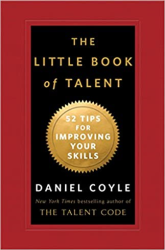# PART I: Getting Started
- Engrave a skill: intense observation, short-burst, repeat.
- Spartan - humble spaces focus attention on deep-practice.
- Luxury - says "relax - you've made it".
- Hard Skills == High Precision
- correctness & consistency
- one path to ideal result
- repeatable precision
- Soft Skills == High Flexibility
- agility & interactive
- recognizing patterns and making smart, timely choices
- broader, less-specialized
- Identify the type of skill. TIP: skills with coaching are usually hard skills
- Hard Skills - careful, slow and keenly attuned to errors.
- Our brains are good at building connections but bad at unbuilding them.
- Soft Skills - play & exploration inside challenging, changing environments.
- High number of varied reps with clear feedback; errors happen during exploration.
- Prioritize Hard Skills
# PART II: Improving Skills
- Learn in the sweet spot - right on the edge of ability:
- comfort zone (ease / effortless / flow)
- SWEET SPOT (frustration, difficulty, alertness to errors) ENGAGED
- survival zone (confusion, desperation, scrambling, guessing)
- TIP: Avoid flow. Do what does not come easy.
- Deep practice is measured in high-quality reaches and repetitions, not time.
- Break moves down into chunks:
- see the whole
- identify smallest masterable element
- find other chunks that link to mastered chunk
- put them together
- Embrace struggle
- 5 minutes per day > an hour per week
- practice alone
- best way to find your sweet spot
- develops discipline
- Think in images: easier to grasp, recall and perform.
- Attend to errors immediately to prevent them from becoming habits (which are hard to break).
- Slow Down, even slower than you think.
- When you get it right, mark the spot. This is the new starting point.
- TIP To Master a Skill, Master Something Harder.
- To learn a new move, exaggerate it, then dial back later. First find the outer edges of the move, then build precision
- Focus on achieving the target, not avoiding the mistake
- TIP Create Beauty, Don’t Avoid Ugliness. Have an image of what perfect execution looks like that includes all of the relevant senses
- Weaker performers try to reactively move away from mistakes, while stronger performers move towards a perfect mental image.
- 3x10: practice 3 times with 10 minute breaks between reps.
- Stop before you're exhausted.
- Practice immediately after performance, and end on a positive note.
# PART III: Sustaining Progress
- Embrace Repetition; this reinforces skills with biological mechanism for making the wires of our brains faster and more accurate.
- Blue-Collar mindset: inspiration is for amateurs; pros go to work every day, whether they feel like it or not.
- For every hour of performance, spend 5 hours of practicing.
- Don't break bad habits, displace them with new ones.
- Our brains are good at building circuits not unbuilding them. Ignore the bad habit and put energy toward building a new habit to override the old one.
- To learn a skill more deeply, teach it. Teaching something well forces you to go through the processes outlined above, which benefits your learning too.
- Give a new skill time to mature and develop. Anecdotally 8 weeks seems to be common.
- When you plateau, shift. You get stuck on autopilot, performing without conscious thought. Change practice method to disrupt the automatic response. Change:
- speed
- order
- timing
- TIP Systematically eliminate weakness (handicap your strengths).
- Keep your big goals secret. Sharing goals tricks your brain into thinking you've already accomplished something and then we don't work as hard or long, and it reduces motivation.
